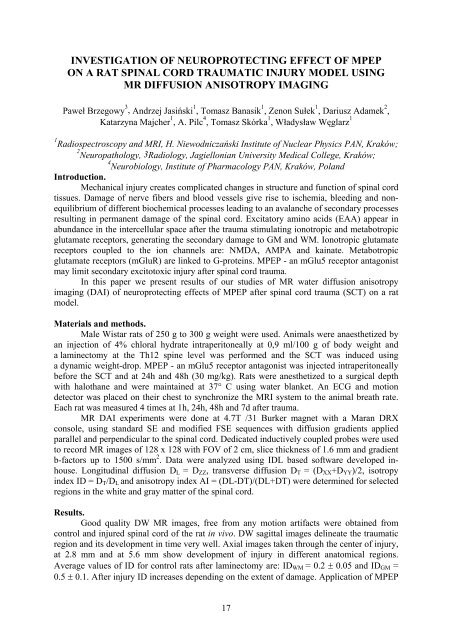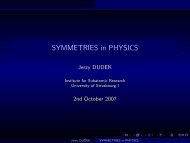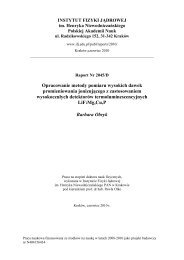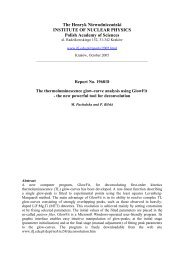Report No xxxx - Instytut Fizyki JÄ drowej PAN
Report No xxxx - Instytut Fizyki JÄ drowej PAN
Report No xxxx - Instytut Fizyki JÄ drowej PAN
Create successful ePaper yourself
Turn your PDF publications into a flip-book with our unique Google optimized e-Paper software.
INVESTIGATION OF NEUROPROTECTING EFFECT OF MPEP<br />
ON A RAT SPINAL CORD TRAUMATIC INJURY MODEL USING<br />
MR DIFFUSION ANISOTROPY IMAGING<br />
Paweł Brzegowy 3 , Andrzej Jasiński 1 , Tomasz Banasik 1 , Zenon Sułek 1 , Dariusz Adamek 2 ,<br />
Katarzyna Majcher 1 , A. Pilc 4 , Tomasz Skórka 1 , Władysław Węglarz 1<br />
1<br />
Radiospectroscopy and MRI, H. Niewodniczański Institute of Nuclear Physics <strong>PAN</strong>, Kraków;<br />
2<br />
Neuropathology, 3Radiology, Jagiellonian University Medical College, Kraków;<br />
4<br />
Neurobiology, Institute of Pharmacology <strong>PAN</strong>, Kraków, Poland<br />
Introduction.<br />
Mechanical injury creates complicated changes in structure and function of spinal cord<br />
tissues. Damage of nerve fibers and blood vessels give rise to ischemia, bleeding and nonequilibrium<br />
of different biochemical processes leading to an avalanche of secondary processes<br />
resulting in permanent damage of the spinal cord. Excitatory amino acids (EAA) appear in<br />
abundance in the intercellular space after the trauma stimulating ionotropic and metabotropic<br />
glutamate receptors, generating the secondary damage to GM and WM. Ionotropic glutamate<br />
receptors coupled to the ion channels are: NMDA, AMPA and kainate. Metabotropic<br />
glutamate receptors (mGluR) are linked to G-proteins. MPEP - an mGlu5 receptor antagonist<br />
may limit secondary excitotoxic injury after spinal cord trauma.<br />
In this paper we present results of our studies of MR water diffusion anisotropy<br />
imaging (DAI) of neuroprotecting effects of MPEP after spinal cord trauma (SCT) on a rat<br />
model.<br />
Materials and methods.<br />
Male Wistar rats of 250 g to 300 g weight were used. Animals were anaesthetized by<br />
an injection of 4% chloral hydrate intraperitoneally at 0,9 ml/100 g of body weight and<br />
a laminectomy at the Th12 spine level was performed and the SCT was induced using<br />
a dynamic weight-drop. MPEP - an mGlu5 receptor antagonist was injected intraperitoneally<br />
before the SCT and at 24h and 48h (30 mg/kg). Rats were anesthetized to a surgical depth<br />
with halothane and were maintained at 37° C using water blanket. An ECG and motion<br />
detector was placed on their chest to synchronize the MRI system to the animal breath rate.<br />
Each rat was measured 4 times at 1h, 24h, 48h and 7d after trauma.<br />
MR DAI experiments were done at 4.7T /31 Burker magnet with a Maran DRX<br />
console, using standard SE and modified FSE sequences with diffusion gradients applied<br />
parallel and perpendicular to the spinal cord. Dedicated inductively coupled probes were used<br />
to record MR images of 128 x 128 with FOV of 2 cm, slice thickness of 1.6 mm and gradient<br />
b-factors up to 1500 s/mm 2 . Data were analyzed using IDL based software developed inhouse.<br />
Longitudinal diffusion D L = D ZZ , transverse diffusion D T = (D XX +D YY )/2, isotropy<br />
index ID = D T /D L and anisotropy index AI = (DL-DT)/(DL+DT) were determined for selected<br />
regions in the white and gray matter of the spinal cord.<br />
Results.<br />
Good quality DW MR images, free from any motion artifacts were obtained from<br />
control and injured spinal cord of the rat in vivo. DW sagittal images delineate the traumatic<br />
region and its development in time very well. Axial images taken through the center of injury,<br />
at 2.8 mm and at 5.6 mm show development of injury in different anatomical regions.<br />
Average values of ID for control rats after laminectomy are: ID WM = 0.2 ± 0.05 and ID GM =<br />
0.5 ± 0.1. After injury ID increases depending on the extent of damage. Application of MPEP<br />
17

















